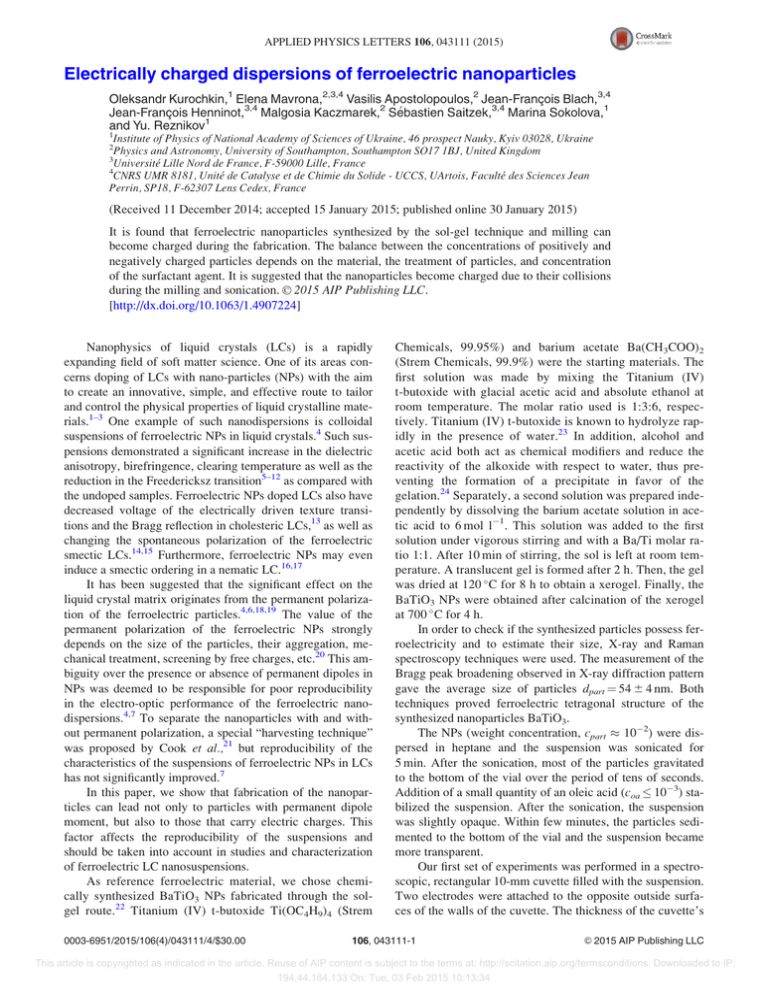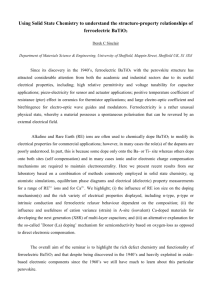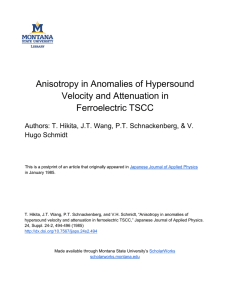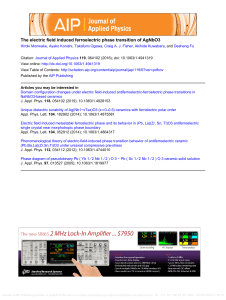Electrically charged dispersions of ferroelectric
advertisement

APPLIED PHYSICS LETTERS 106, 043111 (2015) Electrically charged dispersions of ferroelectric nanoparticles Oleksandr Kurochkin,1 Elena Mavrona,2,3,4 Vasilis Apostolopoulos,2 Jean-François Blach,3,4 bastien Saitzek,3,4 Marina Sokolova,1 Jean-François Henninot,3,4 Malgosia Kaczmarek,2 Se 1 and Yu. Reznikov 1 Institute of Physics of National Academy of Sciences of Ukraine, 46 prospect Nauky, Kyiv 03028, Ukraine Physics and Astronomy, University of Southampton, Southampton SO17 1BJ, United Kingdom 3 Universit e Lille Nord de France, F-59000 Lille, France 4 CNRS UMR 8181, Unit e de Catalyse et de Chimie du Solide - UCCS, UArtois, Facult e des Sciences Jean Perrin, SP18, F-62307 Lens Cedex, France 2 (Received 11 December 2014; accepted 15 January 2015; published online 30 January 2015) It is found that ferroelectric nanoparticles synthesized by the sol-gel technique and milling can become charged during the fabrication. The balance between the concentrations of positively and negatively charged particles depends on the material, the treatment of particles, and concentration of the surfactant agent. It is suggested that the nanoparticles become charged due to their collisions C 2015 AIP Publishing LLC. during the milling and sonication. V [http://dx.doi.org/10.1063/1.4907224] Nanophysics of liquid crystals (LCs) is a rapidly expanding field of soft matter science. One of its areas concerns doping of LCs with nano-particles (NPs) with the aim to create an innovative, simple, and effective route to tailor and control the physical properties of liquid crystalline materials.1–3 One example of such nanodispersions is colloidal suspensions of ferroelectric NPs in liquid crystals.4 Such suspensions demonstrated a significant increase in the dielectric anisotropy, birefringence, clearing temperature as well as the reduction in the Freedericksz transition5–12 as compared with the undoped samples. Ferroelectric NPs doped LCs also have decreased voltage of the electrically driven texture transitions and the Bragg reflection in cholesteric LCs,13 as well as changing the spontaneous polarization of the ferroelectric smectic LCs.14,15 Furthermore, ferroelectric NPs may even induce a smectic ordering in a nematic LC.16,17 It has been suggested that the significant effect on the liquid crystal matrix originates from the permanent polarization of the ferroelectric particles.4,6,18,19 The value of the permanent polarization of the ferroelectric NPs strongly depends on the size of the particles, their aggregation, mechanical treatment, screening by free charges, etc.20 This ambiguity over the presence or absence of permanent dipoles in NPs was deemed to be responsible for poor reproducibility in the electro-optic performance of the ferroelectric nanodispersions.4,7 To separate the nanoparticles with and without permanent polarization, a special “harvesting technique” was proposed by Cook et al.,21 but reproducibility of the characteristics of the suspensions of ferroelectric NPs in LCs has not significantly improved.7 In this paper, we show that fabrication of the nanoparticles can lead not only to particles with permanent dipole moment, but also to those that carry electric charges. This factor affects the reproducibility of the suspensions and should be taken into account in studies and characterization of ferroelectric LC nanosuspensions. As reference ferroelectric material, we chose chemically synthesized BaTiO3 NPs fabricated through the solgel route.22 Titanium (IV) t-butoxide Ti(OC4H9)4 (Strem 0003-6951/2015/106(4)/043111/4/$30.00 Chemicals, 99.95%) and barium acetate Ba(CH3COO)2 (Strem Chemicals, 99.9%) were the starting materials. The first solution was made by mixing the Titanium (IV) t-butoxide with glacial acetic acid and absolute ethanol at room temperature. The molar ratio used is 1:3:6, respectively. Titanium (IV) t-butoxide is known to hydrolyze rapidly in the presence of water.23 In addition, alcohol and acetic acid both act as chemical modifiers and reduce the reactivity of the alkoxide with respect to water, thus preventing the formation of a precipitate in favor of the gelation.24 Separately, a second solution was prepared independently by dissolving the barium acetate solution in acetic acid to 6 mol l1. This solution was added to the first solution under vigorous stirring and with a Ba/Ti molar ratio 1:1. After 10 min of stirring, the sol is left at room temperature. A translucent gel is formed after 2 h. Then, the gel was dried at 120 C for 8 h to obtain a xerogel. Finally, the BaTiO3 NPs were obtained after calcination of the xerogel at 700 C for 4 h. In order to check if the synthesized particles possess ferroelectricity and to estimate their size, X-ray and Raman spectroscopy techniques were used. The measurement of the Bragg peak broadening observed in X-ray diffraction pattern gave the average size of particles dpart ¼ 54 6 4 nm. Both techniques proved ferroelectric tetragonal structure of the synthesized nanoparticles BaTiO3. The NPs (weight concentration, cpart 102) were dispersed in heptane and the suspension was sonicated for 5 min. After the sonication, most of the particles gravitated to the bottom of the vial over the period of tens of seconds. Addition of a small quantity of an oleic acid (coa 103) stabilized the suspension. After the sonication, the suspension was slightly opaque. Within few minutes, the particles sedimented to the bottom of the vial and the suspension became more transparent. Our first set of experiments was performed in a spectroscopic, rectangular 10-mm cuvette filled with the suspension. Two electrodes were attached to the opposite outside surfaces of the walls of the cuvette. The thickness of the cuvette’s 106, 043111-1 C 2015 AIP Publishing LLC V This article is copyrighted as indicated in the article. Reuse of AIP content is subject to the terms at: http://scitation.aip.org/termsconditions. Downloaded to IP: 194.44.164.133 On: Tue, 03 Feb 2015 10:13:34







